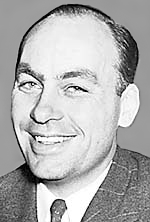乔治·盖洛普
| 乔治·盖洛普 | |
|---|---|
 | |
| 出生 | 乔治·贺拉斯·盖洛普 1901年11月18日 |
| 逝世 | 1984年7月26日(82岁) |
| 母校 | 爱荷华大学 |
| 职业 | 统计学家 |
| 知名于 | 盖洛普民意调查 |
乔治·贺拉斯·盖洛普(英语:George Horace Gallup,1901年11月18日—1984年7月26日),是美国科学民调的先驱,运用统计学原理进行民调,成立盖洛普民意调查,属于抽样调查方法的创始人。
个人生涯
[编辑]

盖洛普出生在美国爱荷华州杰弗逊市。其父亲乔治·亨利·盖洛普是位奶农。年轻时的盖洛普(别名Ted)透过运送牛奶赚取薪水,并于高中时期成立报纸,亦热爱足球。他就读于爱荷华大学,既是足球选手、SAE兄弟会、大学校园独立报《每日爱荷华(The Daily Iowan)》的编辑。他于1923年取得文学士学位,1925年取得文学士硕士,1928年取得博士。[1]
他其后搬迁至狄蒙,于德雷克大学新闻系任职系主任,直至1931年。那年他移至伊利诺伊州的埃文斯顿,于西北大学新闻及广告系任职教授。隔年他移至纽约市,加入扬雅(Young & Rubicam)广告公司任职研究总监(其后于1937年至1947年任职副总裁)。1935年,他短暂担任哥伦比亚大学新闻系教授,但随即成立自己的民调公司,美国公共意见研究所(American Institute of Public Opinion,盖洛普的前身)。[2]
盖洛普常被誉为民调的创始者。1932年,盖洛普为他的岳母米勒(Ola Babcock Miller)进行民调。米勒当时正在竞逐爱阿华州州长。随着民主党那年压倒性的大胜,米勒当选州长,令盖洛普对政治的兴趣更进一步。[3]
1936年美国总统选举,盖洛普研究机构仅仅访问了50,000名受访者就正确预测富兰克林·罗斯福会击败阿尔夫·兰登当选,盖洛普从此声名大噪。与之相反是此前备受推崇的《文学文摘(The Literary Digest)》民调,根据230万份问卷而预测阿尔夫·兰登会当选。盖洛普访问更少的随机样本,不单正确预测选举结果,更正确预测《文学文摘》的预测结果会错误。
20年后,盖洛普机构却遭滑铁卢,该机构对于1948年美国总统选举预测汤玛斯·杜威会以5-15%击败哈瑞·S·杜鲁门当选,但结果大幅失准,盖洛普将此错误归咎为民调于大选前三星期已经停止的缘故。
1947年,他创立盖洛普国际协会(Gallup International Association),是国际性民调机构。[4]
1948年,他与罗宾逊(Claude E. Robinson)成立盖洛普和罗宾逊(Gallup and Robinson)广告研究公司。
1958年,盖洛普重组旗下民调机构成立盖洛普公司。
盖洛普因为心脏病于1984年,在其位于瑞士伯恩高地的避暑山庄逝世,葬于普林斯顿墓园。他的妻子于1988年逝世,其作家儿子乔治·盖洛普 Jr,于2011年逝世。[5]
另见
[编辑]参见
[编辑]- ^ Rogers, Everett M. Iowa School of Journalism. [June 13, 2012]. (原始内容存档于2014-11-07).
- ^ George Gallup Biography. Encyclopedia of World Biography. [June 13, 2012]. (原始内容存档于2020-11-14).
- ^ The Biographical Dictionary of Iowa-Eunice Viola Babcock Miller. [2015-11-09]. (原始内容存档于2018-04-24).
- ^ Wolfgang Donsbach and Michael W. Traugott (2007).
- ^ "N.Y. Times reporter Tom Wicker was acclaimed for Kennedy assassination coverage".
传记
[编辑]- Cantril, Hadley. Gauging Public Opinion (1944)
- Cantril, Hadley and Mildred Strunk, eds. (页面存档备份,存于互联网档案馆)Public Opinion, 1935–1946 (1951)(页面存档备份,存于互联网档案馆), massive compilation of many public opinion polls from US, UK, Canada, Australia, and elsewhere.
- Converse, Jean M. Survey Research in the United States: Roots and Emergence 1890–1960 (1987), the standard history
- Doktorov, Boris Z. "George Gallup: Biography and Destiny." Moscow: (2011)
- Foley, Ryan J., Gallup Papers Give Glimpse into US Polling History, Associated Press (2012)(页面存档备份,存于互联网档案馆)
- Gallup, George. Public Opinion in a Democracy (1939)
- Gallup, Alec M. ed. The Gallup Poll Cumulative Index: Public Opinion, 1935–1997 (1999) lists 10,000+ questions, but no results
- Gallup, George Horace, ed. The Gallup Poll; Public Opinion, 1935–1971 3 vol (1972) summarizes results of each poll.
- Hawbaker, Becky Wilson. "Taking 'the Pulse of Democracy': George Gallup, Iowa, and the Origin of the Gallup Poll." The Palimpsest 74(3) 98–118. Description of Gallup's Iowa years and their impact on his development.
- Lavrakas, Paul J. et al. eds. (页面存档备份,存于互联网档案馆)Presidential Polls and the News Media (1995)(页面存档备份,存于互联网档案馆)
- Moore, David W. The Superpollsters: How They Measure and Manipulate Public Opinion in America (1995)(页面存档备份,存于互联网档案馆)
- Ohmer, Susan. George Gallup in Hollywood. Columbia University Press. 2006. ISBN 978-0-231-12133-0.
- Rogers, Lindsay. The Pollsters: Public Opinion, Politics, and Democratic Leadership (1949)
- Traugott, Michael W. The Voter's Guide to Election Polls(页面存档备份,存于互联网档案馆)[1](页面存档备份,存于互联网档案馆) 3rd ed. (2004)
- Young, Michael L. Dictionary of Polling: The Language of Contemporary Opinion Research (1992)(页面存档备份,存于互联网档案馆)
